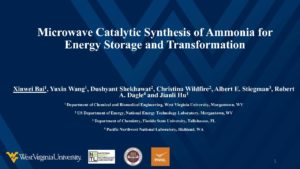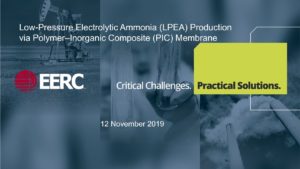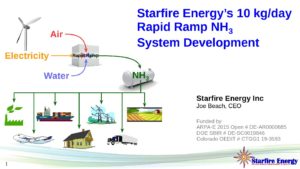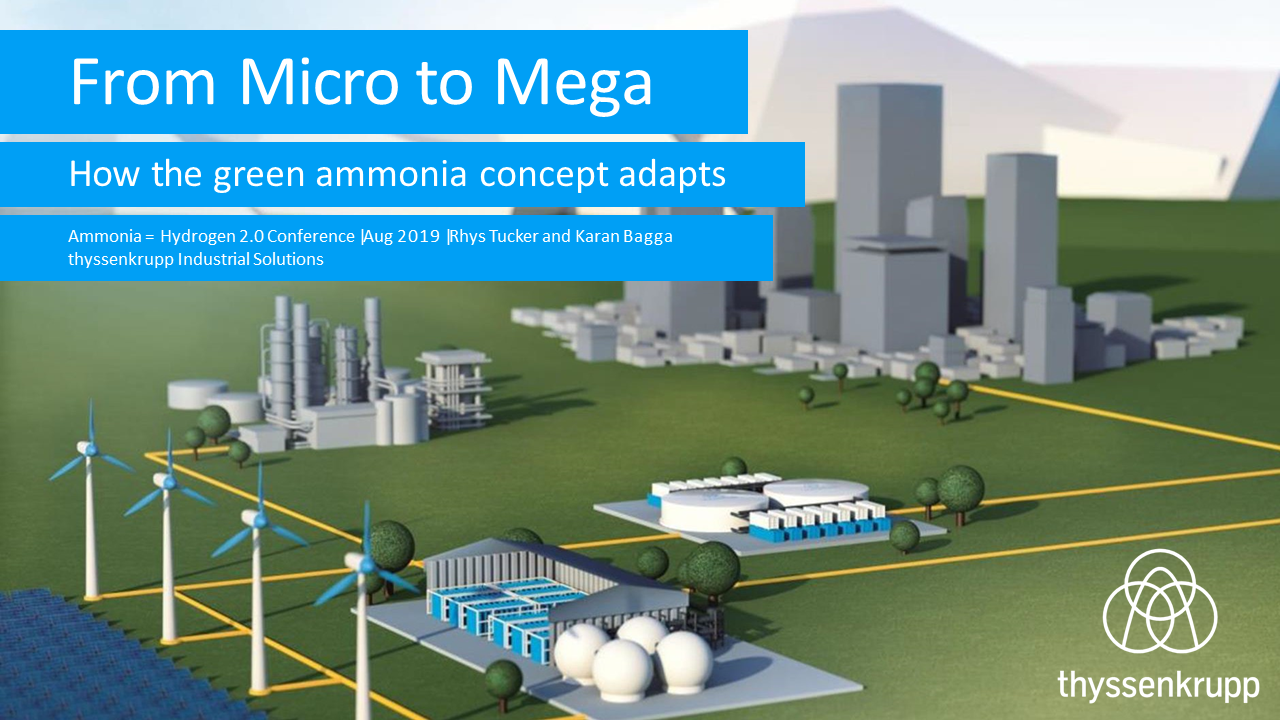Our dependence on ammonia is not limited to development of fertilizers and other chemicals. Ammonia is being considered an energy vector, capable of being used for energy storage as well as fuel, due to its high energy density, ease of storage and transportation. Growing need for ammonia has forced development of alternate strategies for synthesis worldwide to serve as back up of Haber Bosch. Electrochemical ammonia synthesis is one such alternative. Earlier, we found that, nitrogen vacancy in metal-organic framework-derived disordered carbon is active for nitrogen reduction in alkaline electrolytes. We tried to investigate Fe-N4 sites for nitrogen reduction. It…
Improved Haber-Bosch
Presentation
Yittria-Stabilized Zirconia (YSZ) Supports for Low Temperature Ammonia Synthesis
NH3 is important as the raw material for fertilizer production and high hydrogen density (17.7 wt. %) energy carrier. Conventionally, NH3 is synthesized through the well-known Haber-Bosch process at 400-500°C and P~150 bar. Both critical reaction conditions and massive production (145 mt NH3 in 2014 globally) make it one of the most energy extensive process, consuming 1-2% of the world’s total energy expense. Here we introduce YSZ as a more active Ru catalyst support than traditionally used supports such as Al2O3. The addition of Cs promoter increased rates an order of magnitude higher by reducing the apparent activation energy from…
Presentation
Ammonia Generation By Low Energy Electrical Corona Discharge Processes
Ammonia is considered as an important chemical used in agriculture, household cleaning and manufacturing. Mass production of ammonia mostly uses the Haber-Bosch process, reacting hydrogen and nitrogen. However, this process requires a moderately-elevated temperature (450°C) and high pressure (100 bar). Therefore, the development of technologies to produce ammonia with a moderate operation condition and a higher energy efficiency would have a positive economic impact and simulate new approaches in industrial chemistry. Reactors enable single discharge and multi-discharge operation have been built, and their performance proves the concept of conversion of nitrogen and hydrogen and demonstrates the ability to produce ammonia.…
Presentation
Activation By High Temperature Reduction of Ru Catalyst Supported on Rare Earth Oxide for Ammonia Synthesis
Ammonia is an important chemical feedstock, and more than 80% of the synthesized ammonia is used to produce fertilizer. Ammonia is also being considered as an energy carrier and hydrogen source (1) because it has a high energy density (12.8 GJ m-3) and a high hydrogen content (17.6 wt%), (2) because infrastructure for ammonia storage and transportation is already established, and (3) because carbon dioxide is not emitted when ammonia is decomposed to produce hydrogen. If ammonia could be efficiently produced from a renewable energy source, such as solar or wind energy, problems related to the global energy crisis could…
Presentation
Microwave Catalytic Synthesis of Ammonia for Energy Storage and Transformation
This paper presents an innovative approach of producing energy-dense, carbon-neutral liquid ammonia as a means of energy carrier. The approach synergistically integrates microwave reaction chemistry with novel heterogeneous catalysis that decouples N2 activation from high temperature and high pressure reaction, altering reaction pathways and lowering activation energy. Results have shown that ammonia synthesis can be carried out at 280 ℃ and ambient pressure to achieve ~1 mmol NH3/g cat. /hour over supported Ru catalyst systems. Adding promoters of K, Ce and Ba has significantly improved the ammonia production rate over Ru-based catalysts that could be attributing to enhanced electromagnetic sensitivity…
Presentation
300°C Proton-Exchange Membrane for Low-Pressure Electrolytic Ammonia Synthesis
The two North Dakota universities and Proton OnSite are developing a 300°C-capable polymer–inorganic composite (PIC) proton exchange membrane for low-pressure (15-psi) ammonia synthesis. The PIC membrane comprises an inorganic proton conductor strategically composited within a high-temperature polymer to enable a proton conductivity of 10-2 siemens/centimeter at 300°C. Integrated with appropriate low-cost anode and cathode catalysts in a membrane–electrode assembly, the gas-impermeable PIC membrane is projected to enable ammonia production at a total energy input of about 6400 kilowatt-hours/ton (kWh/ton), versus about 8500 kWh/ton for state-of-the-art Haber Bosch-based ammonia production. The PIC membrane will also have application in high-temperature water electrolysis…
Presentation
Starfire Energy's 10 Kg/Day Rapid Ramp NH3 System Development
Starfire Energy is building a 10 kg/day NH3 synthesis system using its low pressure Rapid Ramp NH3 process. The system includes hydrogen production by proton exchange membrane electrolyzer, nitrogen production by pressure swing adsorption, NH3 synthesis, and liquid NH3 storage. The tight coupling of the hydrogen, nitrogen, and NH3 processes require minimal reactant buffering. The system design, status, and preliminary performance will be discussed.
Presentation
From Micro to Mega, how the green ammonia concept adapts
Green ammonia concepts from thyssenkrupp are available from 50 to over 5000 tonnes per day. Variability of electrolytic hydrogen feed presents one of the biggest and unique challenge in achieving an optimal and stable functioning of the Haber-Bosch synthesis loop. The solutions to these challenges require a customised approach, dependent on scale and power generation mix of the of the facility. At thyssenkrupp, Australia, we offer local expertise in optimising the concepts for your small and large scale green ammonia applications, underpinned by our know how as a world leading electrolysis and ammonia technology supplier.
Presentation
Demonstration of CO2-Free Ammonia Synthesis Using Renewable Energy-Generated Hydrogen
In Japan, the government funding project SIP, Strategic Innovation Promotion Program, supports the research, development and demonstration of “Energy Carriers”. The concept of the “Energy Carriers” value chain is to produce hydrogen energy carriers overseas from fossil resources using CCS or renewable energy, and transport it to Japan for utilization as clean energy. The purpose of the program is to help realize a low-carbon society in Japan by using hydrogen. Among energy carriers, ammonia is the one of the most promising carriers, because of the ease of transportation as a liquid, higher hydrogen density, and proven technologies for commercial and…





